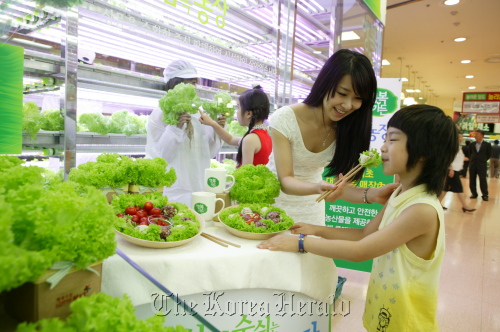Korea has been bolstering the vertical farming industry since 2009 as a future growth engine and a measure to stabilize food supplies.
The country is a latecomer to the scene but is pinning high hopes on its advanced technologies in electronics and communications to help it emerge as a competitive player in the field.
The concept of integrating agriculture into a built environment was invented in a Danish farmhouse back in the 1950s that attempted to grow cress ― a peppery, tangy flavored herb botanically related to mustard ― in a factory on a mass scale.
This type of urban farming is attracting wider attention of late as the world faces simmering food security concerns, arable land loss and reduced access to fresh water propelled by global warming.
The U.S. and European countries like Austria and the Netherlands have been conducting research and development for decades.
Japan is one of the most active players, running more than 50 vertical farms as of 2008 and planning to double the number by 2012.
The Korean government has been supporting a variety of research efforts and farm operations.
The Rural Development Administration is planning to open large-scale vertical farms this month in the National Academy of Agricultural Science in Suwon, Gyeonggi Province.
The facilities will house a geothermal heat pump and solar power system to supply energy and laboratories for technological advancement, RDA officials said.
 |
A boy tries vertical-farm produce at a Seoul discount store. |
“The project will provide a guideline for research and development in vertical farming, and a steppingstone to Korea’s agricultural growth,” said Lee Young-hee, head of the RDA’s production automation machinery department.
The government program has also funded a total of 4 billion won for LED-based vertical farms and related think tanks and universities in North Jeolla Province, southwestern part of the country.
The Jeonju Biomaterials Institute launched a vertical farm last March in the province as a test-bed for the technology. Researchers have been planting things like lettuce, watercress, chicory and ginseng in a 132-square-meter area.
Ginseng grew twice as fast than its normally slow cycle because the farm provided an adequate habitat for the herbal plant, said Doo Hong-soo, director of the think tank’s natural food additives development center.
“We’re trying to see if we can scale up the facilities to the extent of mass production,” he said. “Focusing on technology development, we’re doing lots of experiments with high value-added products like medical herbs and imported species to improve economic viability.”
Chonbuk National University in Jeonju also opened a complex in January, which will accommodate laboratories for seed-testing and crop production and companies in food and LED industries.
North Jeolla Province aims to create 30,000 jobs at 150 firms in the vertical farming sector and fetch 3 trillion won in annual sales by 2020, taking a lead in the country’s green growth initiatives.
It plans to spend 500 billion won by 2018 ― 300 billion won in building industrial complexes, 100 billion won in R&D, 70 billion won in producing key industry players and 30 billion won in nurturing labor forces.
Such efforts would boost Korea’s sagging competitiveness on the global agricultural stage, scientists said, and help them dig into new farming technologies that can lead the future.
The Jeonju Biomaterials Institute, for example, is developing a mechanism in which vertical farms are operated with no heating or air-conditioning equipment, Doo said.
By Shin Hyon-hee (
heeshin@heraldcorp.com)








